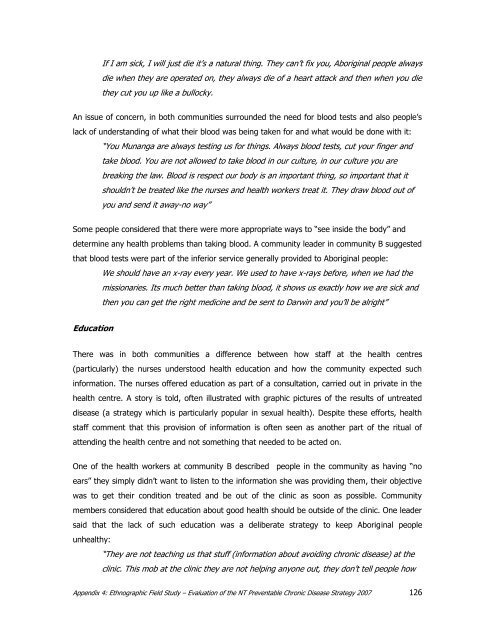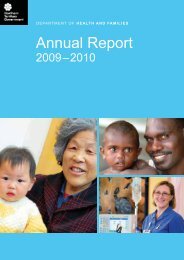PCD Strategy Evaluation 2007.pdf - NT Health Digital Library ...
PCD Strategy Evaluation 2007.pdf - NT Health Digital Library ...
PCD Strategy Evaluation 2007.pdf - NT Health Digital Library ...
Create successful ePaper yourself
Turn your PDF publications into a flip-book with our unique Google optimized e-Paper software.
If I am sick, I will just die it‟s a natural thing. They can‟t fix you, Aboriginal people alwaysdie when they are operated on, they always die of a heart attack and then when you diethey cut you up like a bullocky.An issue of concern, in both communities surrounded the need for blood tests and also people‟slack of understanding of what their blood was being taken for and what would be done with it:“You Munanga are always testing us for things. Always blood tests, cut your finger andtake blood. You are not allowed to take blood in our culture, in our culture you arebreaking the law. Blood is respect our body is an important thing, so important that itshouldn‟t be treated like the nurses and health workers treat it. They draw blood out ofyou and send it away-no way”Some people considered that there were more appropriate ways to “see inside the body” anddetermine any health problems than taking blood. A community leader in community B suggestedthat blood tests were part of the inferior service generally provided to Aboriginal people:We should have an x-ray every year. We used to have x-rays before, when we had themissionaries. Its much better than taking blood, it shows us exactly how we are sick andthen you can get the right medicine and be sent to Darwin and you‟ll be alright”EducationThere was in both communities a difference between how staff at the health centres(particularly) the nurses understood health education and how the community expected suchinformation. The nurses offered education as part of a consultation, carried out in private in thehealth centre. A story is told, often illustrated with graphic pictures of the results of untreateddisease (a strategy which is particularly popular in sexual health). Despite these efforts, healthstaff comment that this provision of information is often seen as another part of the ritual ofattending the health centre and not something that needed to be acted on.One of the health workers at community B described people in the community as having “noears” they simply didn‟t want to listen to the information she was providing them, their objectivewas to get their condition treated and be out of the clinic as soon as possible. Communitymembers considered that education about good health should be outside of the clinic. One leadersaid that the lack of such education was a deliberate strategy to keep Aboriginal peopleunhealthy:“They are not teaching us that stuff (information about avoiding chronic disease) at theclinic. This mob at the clinic they are not helping anyone out, they don‟t tell people howAppendix 4: Ethnographic Field Study – <strong>Evaluation</strong> of the <strong>NT</strong> Preventable Chronic Disease <strong>Strategy</strong> 2007 126
















